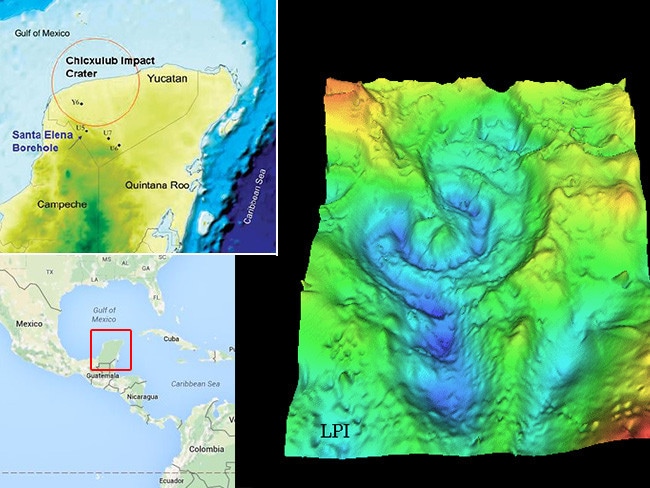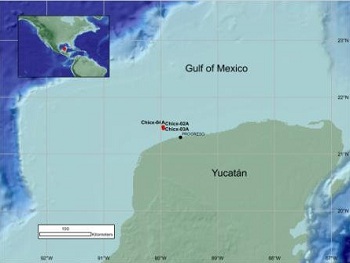The moment an asteroid slammed into Mexico 66 million years ago, triggering the mass extinction that killed the dinosaurs, is probably the single most dramatic event in the history of the world. Now scientists want to find it.
Later this month a drilling platform will set to anchor in the Gulf of Mexico. Guess what, it’s not seeking oil.
Instead, it will be drilling deep into the scar that is the enormous Chicxulub crater.
From the recovered rock cores, researchers hope to understand exactly what it took to blast the 180km hole in our planet — and how life re-established itself after such a cataclysmic event.
EARTH-SHATTERING EVENT

A rendering of seismic scan data for the Chicxulub crater, on the Yucatán Peninsula, Mexico. (Photo: news.com.au)
Estimated at some 12km across, the enormous space rock slammed through the Earth’s crust and blasted megatons of dust and rock high into the atmosphere. Enormous tsunamis were thrown up and firestorms raged across the planet. But the dinosaurs didn’t have the right stuff to survive.
About 75% of all life ultimately went extinct. Those that remained evolved into the birds and mammals we know today.
The world had changed. But we’re not exactly sure how.
Some researchers believe the oceans acidified and the atmosphere changed due to an enormous release of carbon dioxide from the impact.
The minerals and fossilised seashells found among the remains of Chicxulub’s ‘Ground Zero’ could provide the answers to these questions.
SCRATCHING THE SURFACE

Beneath millions of years of infill, scientists expect to uncover a timeline of the impact — and Earth’s recovery. (Photo: news.com.au)
Scientific expeditions to the Yucatán coast have been jealously prevented by oil companies seeking to keep their surveys secret in the 20 years since the Chicxulub crater was discovered.
But times have changed.
Later this month, a specially equipped drilling platform — dubbed Expedition 364 — will anchor some 30km offshore from Mexico.
The position has been carefully chosen from subsurface images of the crater: They’re aiming for the crater’s peak ring — a band of mountainous rubble thrown up by the rebound of the Earth’s surface.
It’s hoped this area would have trapped much of the debris that fell back after the impact.
On April 1, the $10 million project aims to send a diamond-tipped drill through the 17m deep waters and into 500m of seabed sediment and limestone to find out.

Anatomy of an impact crater. Chicxulub is expected to be like other large impact points seen in our solar system.(Photo: news.com.au)
Once this surface — built up over the intervening 66 million years — has been pierced, things will heat up.
The drill will extract samples in 3m long chunks.
Over the course of two months, the researchers hope to dig up a kilometre worth of a fossilised timeline reaching back to the impact itself.
The first sign is expected to be a layer of hardened ash. It would be an 100m deep patch of scorched earth — the stuff that rained from the skies in the weeks and months after the event.
At its base is likely to be a layer of blasted bedrock and lava which fused as the sediment-heavy ocean swept back into the crater in the minutes after impact.

The Chicxulub event not only killed through its impact, but set in chain a string of Earth-changing events. (Picture: Walking with Dinosaurs / BBCSource:News Corp Australia)
A HOLE IN TIME
Every core sample pulled from beneath the ocean’s surface will be closely examined and integrated into a timeline of rock types, minerals and micro-fossils.
Even DNA is expected to be extracted.
But once the drill passes 800m, things are expected to change.
Limestone — formed by layer upon layer of dead tiny shellfish — is expected to cease.
What lies beneath will be a revelation.
Are the rocks porous and fractured? Did molten minerals seep their way to the surface? Were there hot vents jetting up from beneath the crust?
What microbes were among the first toehold of life to return?
Traces of such sea life will reveal much about the acidity and conditions of the post-impact world’s oceans. This would have been a major driver in the Darwinian struggle of life-and-death that ensued.
Conclusion: Once seen as the least glamorous objects in the solar system, it now looks like asteroids could hold clues to how the Earth was formed, how life began and ultimately, how it will end.
By
Source: http://www.news.com.au/





